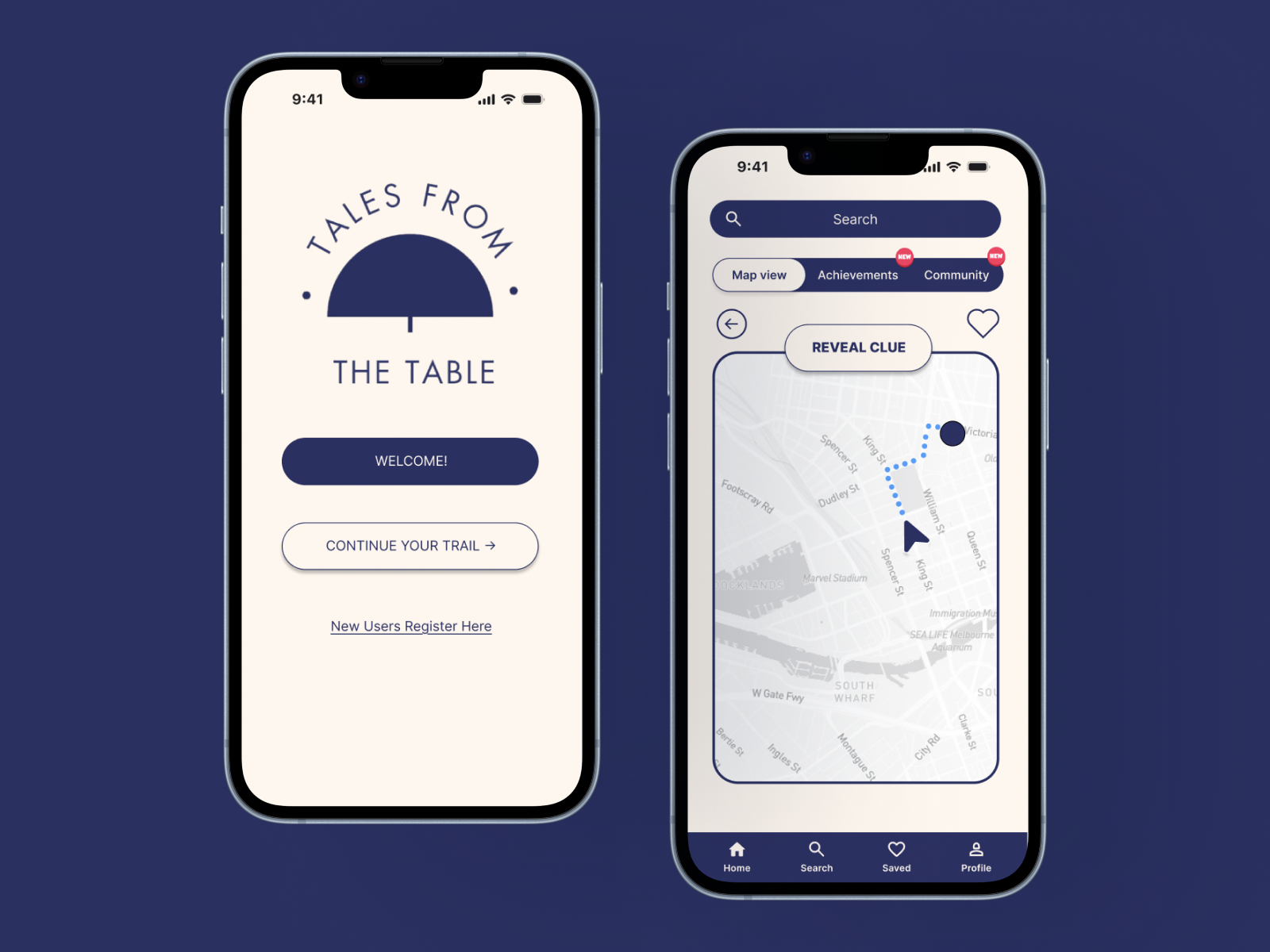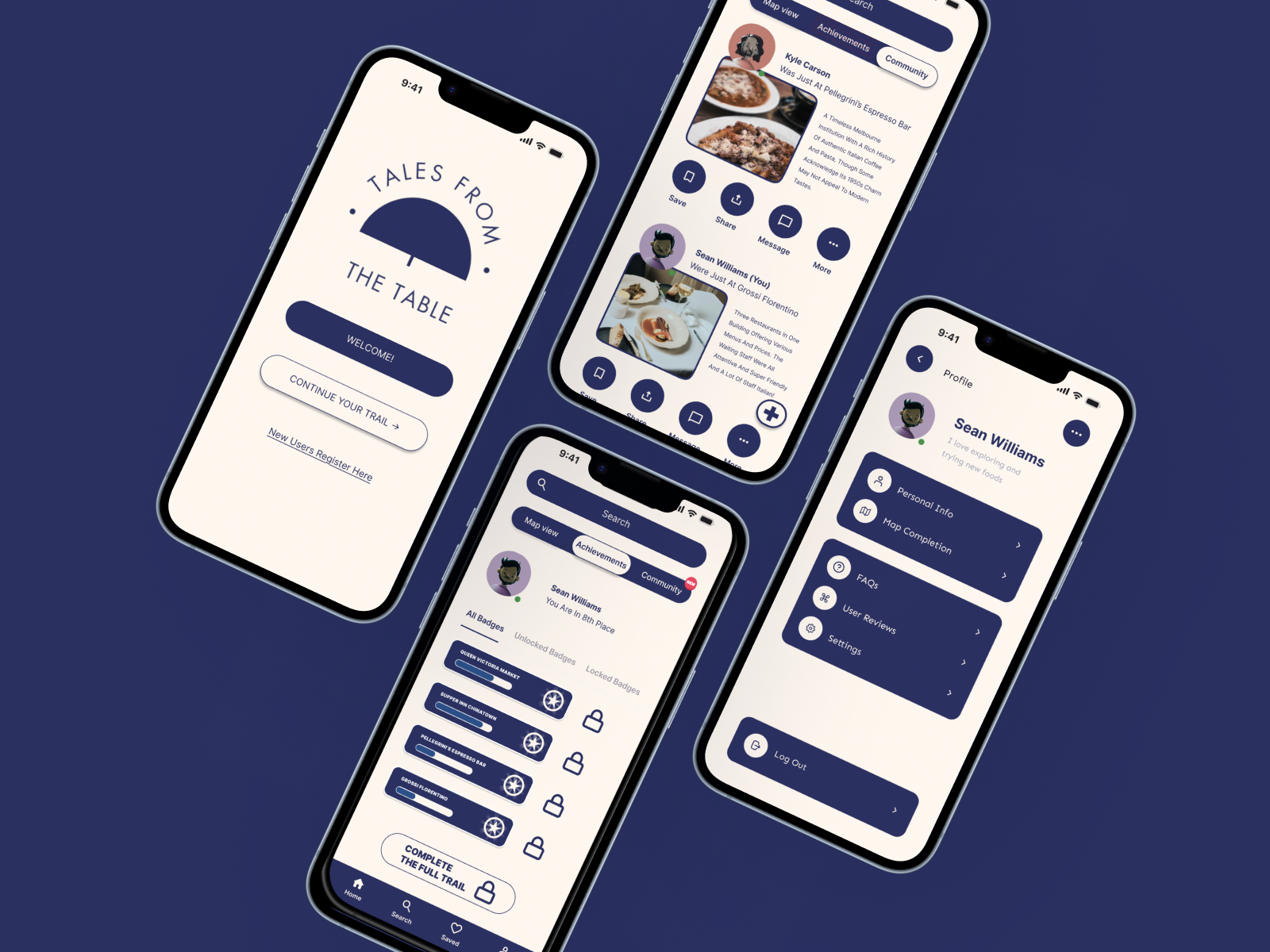
Overview
Project Brief
Tales from the Table is a geolocated storytelling trail that blends food, culture, and narrative into an interactive mobile experience. Designed around ten locations across Melbourne, the project transforms the city’s dining landmarks into story touchpoints, where each scan unlocks a short narrative about food, memory, and cultural heritage.
To design and develop a geolocated narrative mobile application that delivers an engaging, site-specific story.
The application must include:
A narrative mapped across 10 locations within a 25km radius.
Integration of simulated geolocation, audio, and camera functionalities.
A thematic focus connecting all narrative points (fictional, historical, or thematic).
This project aims to explore how digital storytelling can merge with physical space to create immersive, location-aware experiences.




Key Objectives
Build an interactive map that guides users through the story’s 10 geolocated points.
Integrate audio and camera features to enhance immersion and user interaction.
Create a cohesive narrative structure that encourages exploration and discovery.
Design a user-friendly interface that blends storytelling and navigation seamlessly.
Problem Statment
How might we design a mobile experience that connects users emotionally and spatially to their surroundings, transforming ordinary locations into immersive storytelling environments?
Research Goals
Understand how users engage with location-based storytelling and AR-driven experiences.
Analyse the narrative structures that best suit geolocated formats.
Explore user motivations for participating in digital city explorations.
Evaluate how sensory features (audio, camera, AR) enhance user immersion.
Concept
Tales from the Table reimagines Melbourne as a living storybook of culinary culture. Each of the ten locations represents a chapter in the city’s food identity. From iconic institutions like Pellegrini’s and Brunetti, to hidden gems such as Soi 38 and Supper Inn, and multicultural eateries including The Abyssinian, Nhu Lan Bakery, and Jim’s Greek Tavern. Larger gathering spaces like Queen Victoria Market and Grazeland, along with fine dining venues like Grossi Florentino, complete the trail, capturing Melbourne’s blend of tradition and innovation.
Interaction Design
The trail uses visual and physical markers, such as signs, murals, and shopfronts, as intuitive cues. Instructions are anchored in scannable, recognisable touchpoints that users can identify quickly. This consistency helps participants feel confident and oriented throughout the trail, while each location maintains its own unique visual identity.
Upon scanning a location, users unlock:
A short narrative tied to the site’s food history or cultural story.
Optional audio playback for hands-free engagement.
Directions to the next stop in the trail.
This simple, repeatable structure keeps the experience accessible and immersive, blending storytelling and exploration seamlessly.
User Testing Insights
User testing through both focus groups and field testing provided valuable feedback on how to refine the Tales from the Table experience. Overall, users found the concept engaging and the storytelling elements memorable, but several usability and clarity issues were identified. New users were sometimes unsure how to begin or navigate the app, and key interactive features went unnoticed. Participants also highlighted environmental factors, such as outdoor visibility, that affected the experience. These insights informed a series of design modifications to improve accessibility, engagement, and consistency across the trail.
Design Modifications
Refinements drawn from Field Testing:
Clear Instructions: Include a brief, visual onboarding screen or pop-up for first-time users with clear guidance on how to interact with the app. Keep it skippable to maintain immersion.
Readability on Popups: Increase popup and overlay size with better padding and contrast for easier reading, and consider adjustable text sizes for accessibility.
Outdoor Visibility: Improve usability in bright conditions with high-contrast colours and lighter backgrounds. Test the interface under varying lighting conditions.
Enhanced Interactivity: Enable optional community features such as photo uploads, comments, and quick reactions on story pages. Maintain clear moderation and privacy settings to ensure user safety.
Refinements drawn from Focus Group:
Highlighting Markers: Add subtle visual cues and highlighted markers to clearly indicate starting points. Maintain consistent marker design across map and story interfaces for better orientation.
Emphasising Key Features: Make onboarding hints and tooltips more noticeable. Use micro-interactions or animations to draw attention to overlooked features like quizzes and community sections.
Community Page: Reorganise layout for easier access to content by prioritising recent or popular posts and adding filters. Display community updates more prominently to encourage participation.
Skippable Tutorial Tips: Introduce optional, skippable tips for first-time users, offering light guidance without interrupting self-directed exploration.
Reflection
Working on Tales from the Table demonstrated the importance of designing for clarity, accessibility, and connection in a location-based storytelling experience. The project’s success depended not only on compelling narrative design but also on ensuring every interaction felt intuitive and rewarding.
Iterative feedback through focus groups and field testing was invaluable in shaping a product that remained both culturally immersive and user-friendly.
Through this process, I learned how subtle interface decisions directly influence user confidence and enjoyment, especially in outdoor, on-the-go contexts.
Takeaways
Iterative feedback bridges the gap between creative storytelling and functional design.
Clarity and accessibility are essential for outdoor, mobile-first experiences.
Micro-interactions and subtle animations enhance feature visibility without disrupting flow.
Community engagement features can deepen connection and extend the story beyond the app.
Designing for real-world conditions (sunlight and motion) ensures inclusivity and usability in all environments.

